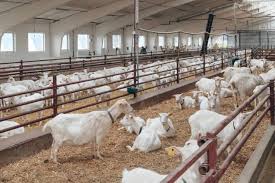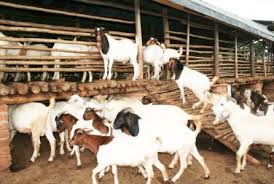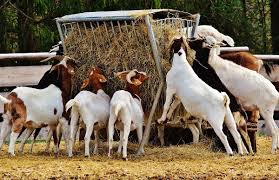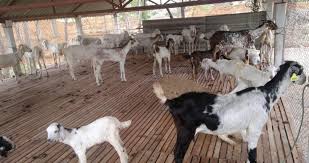Goat Farming Techniques are essential practices that enable farmers to raise healthy goats while maximizing productivity and profitability. Goats are one of the most adaptable and resilient livestock species, making them an excellent choice for smallholder farmers and commercial producers alike.
Their ability to thrive in various environments, from arid regions to lush pastures, allows them to be raised almost anywhere, making goat farming a viable agricultural enterprise globally.
The key to successful goat farming lies in understanding their unique needs and characteristics. Goats are browsers, meaning they prefer to eat bushes, shrubs, and trees over grass, which differentiates them from many other livestock species.
This feeding habit allows them to thrive in areas with limited forage, turning otherwise unusable land into productive grazing resources. Selecting the right breed is also crucial, as different goat breeds serve different purposes, such as milk production, meat, fiber, or dual-purpose. Breeds like the Boer goat are well-known for their meat production, while the Saanen and Nubian goats are popular choices for milk production.
Proper housing is another vital aspect of goat farming techniques. Goats require well-ventilated shelters that protect them from extreme weather conditions, including rain, heat, and cold. A good goat shelter should also be clean and dry to prevent the spread of diseases.
Additionally, providing enough space for goats to move around freely is important for their physical and mental well-being. This space not only contributes to their overall health but also helps reduce stress, which can lead to better productivity.
Feeding and nutrition are fundamental components of goat farming techniques. A balanced diet is crucial for optimal growth, reproduction, and milk production. Goats require a diet rich in fiber, protein, vitamins, and minerals.
This can be achieved through a combination of pasture grazing, hay, grains, and commercial feeds formulated for goats. It’s also important to provide access to clean, fresh water at all times, as dehydration can significantly affect their health and productivity. Additionally, introducing supplements and minerals can help address nutritional deficiencies and enhance their overall health.
Breeding management is another critical aspect of goat farming techniques. Successful breeding programs ensure a consistent supply of offspring for meat or milk production. Farmers should focus on selecting healthy breeding stock with desirable traits, such as high milk yield or rapid growth rates. Understanding the reproductive cycle of goats and implementing proper breeding techniques, including artificial insemination if necessary, can further enhance productivity.
Health management plays a pivotal role in goat farming techniques. Regular veterinary check-ups, vaccinations, and deworming are essential to keep goats healthy and free from diseases. Establishing a herd health plan can help prevent potential outbreaks and maintain overall herd productivity. Farmers should also be vigilant for any signs of illness or distress, allowing for quick intervention when necessary.
Benefits of Goat Farming

Goat farming offers several advantages for farmers and homesteaders:
1. High Nutritional Value: Goat meat is lean and rich in protein, vitamins, and minerals. It is a healthier alternative to beef and pork, making it increasingly popular among health-conscious consumers.
2. Milk Production: Goats are excellent milk producers. Goat milk is nutritious and easier to digest than cow’s milk, making it a popular choice for those with lactose intolerance.
3. Low Maintenance: Goats are hardy animals that require less space and feed compared to larger livestock. This makes them ideal for small farms or homesteads.
4. Efficient Grazers: Goats are natural browsers and can thrive on a variety of vegetation, including shrubs and weeds. They help maintain pasture health and control unwanted plants.
5. Quick Reproduction: Goats have a short gestation period of about five months, allowing for more frequent breeding cycles. This results in a faster return on investment for farmers.
6. Diversification of Income: Farmers can raise goats for various purposes, including meat, milk, fiber (like cashmere or mohair), and land management. This diversification can help stabilize income.
Choosing the Right Goat Breed
Selecting the right goat breed is essential for successful goat farming:
1. Purpose of Farming: Determine the primary purpose of raising goats. Common purposes include meat production, milk production, and fiber production.
2. Meat Goat Breeds: If your focus is on meat production, consider breeds like Boer, Kiko, or Spanish goats. These breeds are known for their fast growth rates and high meat quality.
3. Dairy Goat Breeds: For milk production, popular breeds include Saanen, Nubian, and Alpine goats. These breeds are known for their high milk yield and quality.
4. Fiber Goat Breeds: If you’re interested in fiber production, Angora and Cashmere goats are excellent choices. They produce high-quality fibers used in textiles.
5. Climate and Environment: Choose a breed that is well-suited to your local climate and environment. Some breeds are more adaptable to specific conditions than others.
6. Availability and Cost: Research the availability of your chosen breed in your area and consider the cost of purchasing and maintaining them.
Read Also: Which Herbs and Spices are good for you (cinnamon, paprika, etc)
Housing and Shelter Requirements

Providing proper housing and shelter is crucial for the health and well-being of goats:
1. Space Requirements: Goats need adequate space to move around and exercise. A minimum of 10-15 square feet per goat is recommended for indoor housing. Additionally, they should have access to outdoor grazing areas.
2. Shelter Design: A simple barn or shed can serve as shelter. Ensure it has proper ventilation to keep the air fresh and reduce humidity. The shelter should also be draft-free to protect goats from cold winds.
3. Flooring: The flooring should be clean and dry. Straw, wood shavings, or sand can be used as bedding. Regularly clean the bedding to prevent the buildup of waste and ensure a healthy environment.
4. Fencing: Strong fencing is essential to keep goats safe from predators and prevent them from escaping. Goats are known for their climbing abilities, so the fencing should be at least four to five feet high.
5. Access to Water: Goats need constant access to clean, fresh water. Ensure that their water source is protected from contamination and regularly cleaned.
6. Protection from Extreme Weather: Provide shaded areas for hot weather and windbreaks for cold weather. Adequate shelter will help protect goats from harsh weather conditions.
Nutritional Needs of Goats
Understanding the nutritional requirements of goats is crucial for their health and productivity:
1. Energy Requirements: Goats need energy for growth, maintenance, and production. The primary source of energy is carbohydrates found in forages and grains.
2. Protein Needs: Protein is vital for growth, reproduction, and milk production. Goats require protein from sources like legumes, alfalfa hay, and protein supplements.
3. Minerals: Essential minerals like calcium, phosphorus, and magnesium are necessary for bone development and overall health. Provide mineral blocks or supplements to meet these needs.
4. Vitamins: Goats need vitamins A, D, and E for proper growth and health. Green forage and supplements can help provide these essential vitamins.
5. Water Intake: Fresh, clean water is crucial for goats’ overall health. They should have constant access to water, as dehydration can lead to serious health issues.
6. Balanced Diet: A balanced diet consisting of high-quality forage, grains, and supplements will help meet the nutritional needs of goats, supporting their health and productivity.
Health Management and Disease Prevention
Maintaining goat health is essential for a successful farming operation:
1. Regular Veterinary Check-ups: Schedule routine veterinary visits to monitor the health of your goats and provide necessary vaccinations.
2. Vaccinations: Common vaccinations include CDT (Clostridium perfringens types C and D and tetanus) and rabies. Consult your veterinarian for a vaccination schedule.
3. Parasite Control: Regularly check for internal and external parasites. Use dewormers and follow a parasite management plan to keep goats healthy.
4. Biosecurity Measures: Implement biosecurity practices to prevent the introduction of diseases. This includes quarantining new animals and maintaining clean living conditions.
5. Nutrition Management: Providing a balanced diet helps strengthen the immune system, making goats less susceptible to diseases.
6. Observation: Regularly observe your goats for any signs of illness, such as coughing, lethargy, or changes in appetite. Early detection can prevent the spread of disease.
Breeding Techniques for Goats
Breeding goats requires knowledge and planning:
1. Selecting Breeding Stock: Choose healthy animals with desirable traits, such as good milk production, growth rates, and temperament. Genetic selection can enhance the quality of your herd.
2. Natural Breeding: Allowing bucks and does to mate naturally is common. Ensure proper timing by observing estrus cycles in does, which usually occur every 21 days.
3. Artificial Insemination: This technique allows for the use of superior genetics from distant bucks. It requires trained personnel and proper timing to ensure success.
4. Pregnancy Management: Gestation in goats lasts about five months. Monitor pregnant does closely for any signs of complications.
5. Kidding Preparation: Create a clean, comfortable environment for does to give birth. Have supplies ready, such as clean towels and iodine for umbilical cords.
6. Post-Kidding Care: After kidding, ensure that kids nurse from their mothers promptly. Monitor both the doe and kids for health issues.
Milking and Milk Production
Milking goats can be a profitable venture if managed correctly:
1. Choosing Dairy Breeds: Select breeds known for high milk production, such as Saanen, Nubian, or Alpine goats.
2. Milking Schedule: Establish a regular milking schedule, typically twice a day, to maintain consistent milk production.
3. Cleanliness: Ensure that the milking area and equipment are clean to prevent contamination. Clean the udder before milking to reduce the risk of mastitis.
4. Proper Technique: Use gentle, consistent milking techniques to avoid stressing the goats. Hand milking or using a milking machine can be effective.
5. Nutrition for Milk Production: Provide high-quality feed and minerals to support milk production. A well-balanced diet ensures healthy milk with good nutritional quality.
6. Monitoring Production: Keep records of milk production to identify trends and make adjustments to feeding or management practices as needed.
Goat Behavior and Handling
Understanding goat behavior is essential for effective handling and management:
1. Social Animals: Goats are herd animals and thrive in social settings. Keeping at least two goats together helps reduce stress and promotes natural behaviors.
2. Territoriality: Goats can be territorial. Provide enough space and resources to minimize competition and aggression within the herd.
3. Curiosity and Exploration: Goats are naturally curious and enjoy exploring their environment. Enrichment activities, such as climbing structures or toys, can keep them engaged.
4. Body Language: Learn to recognize goat body language. Signs of stress include raised tails, excessive bleating, or aggressive behavior, while relaxed goats often exhibit a calm demeanor.
5. Gentle Handling: Use calm and gentle handling techniques to reduce stress during tasks like hoof trimming, veterinary care, or milking. Gradual acclimatization to handling will help build trust.
6. Training Opportunities: Goats can be trained to follow commands and navigate obstacles. Positive reinforcement techniques can be effective in training.
Read Also: Hookworms: Description, Damages Caused, Control and Preventive Measures
Waste Management in Goat Farming

Effective waste management is crucial for maintaining a healthy environment in goat farming:
1. Manure Management: Goats produce significant amounts of manure, which can be composted and used as fertilizer. Regular cleaning of the housing area prevents disease and odor.
2. Waste Separation: Consider implementing a waste separation system to distinguish between solid and liquid waste. This can facilitate better composting and nutrient recovery.
3. Composting: Composting goat manure can create a nutrient-rich soil amendment. Proper composting techniques help eliminate pathogens and create a valuable resource for gardens or crops.
4. Water Management: Manage water runoff from waste areas to prevent contamination of nearby water sources. Installing drainage systems can help manage excess water effectively.
5. Pasture Management: Rotate grazing areas to prevent overgrazing and allow pastureland to recover. This reduces the buildup of parasites and improves soil health.
6. Biosecurity Practices: Implement biosecurity measures to minimize disease spread through waste. This includes proper disposal of deceased animals and limiting visitor access to the farm.
Economic Considerations in Goat Farming
Understanding the economic aspects of goat farming is essential for sustainability and profitability:
1. Start-Up Costs: Assess the initial investment required for purchasing goats, housing, feeding, and equipment. Create a budget to manage these expenses.
2. Production Costs: Monitor ongoing costs such as feed, veterinary care, and labor. Regularly review your budget to identify areas for cost savings.
3. Market Research: Conduct market research to identify demand for goat products, such as meat, milk, and fiber. Understanding local markets helps in making informed production decisions.
4. Profitability Analysis: Calculate the profitability of your goat farming operation by comparing income from sales with production costs. Identify which products yield the highest returns.
5. Diversification Opportunities: Consider diversifying your farm by offering various goat products, such as artisanal cheeses, soaps, or fiber goods, to increase revenue streams.
6. Grants and Subsidies: Research available grants, subsidies, and financial assistance programs for goat farmers. This can help alleviate some financial burdens and support growth.
Sustainable Practices in Goat Farming
Implementing sustainable practices benefits both the environment and your farm’s productivity:
1. Rotational Grazing: Use rotational grazing techniques to enhance pasture health and reduce soil erosion. This practice allows forage to recover while providing fresh grazing areas for goats.
2. Organic Feeding: Consider organic feeding practices that avoid synthetic chemicals and support the health of the animals and the environment.
3. Integrated Pest Management: Use integrated pest management strategies to control parasites and pests naturally, reducing the need for chemical treatments.
4. Water Conservation: Implement water conservation techniques, such as rainwater harvesting, to reduce reliance on external water sources and promote sustainability.
5. Biodiversity: Promote biodiversity on your farm by planting a variety of forage crops and maintaining native vegetation. This can improve soil health and provide a balanced diet for goats.
6. Community Engagement: Engage with local communities and organizations to share knowledge and resources related to sustainable goat farming practices. Collaborating with others can foster innovation and support.
Do you have any questions, suggestions, or contributions? If so, please feel free to use the comment box below to share your thoughts. We also encourage you to kindly share this information with others who might benefit from it. Since we can’t reach everyone at once, we truly appreciate your help in spreading the word. Thank you so much for your support and for sharing!
Read Also: Hydroponics Guide 101: All You Need to Know About it
Frequently Asked Questions
We will update this section soon.

